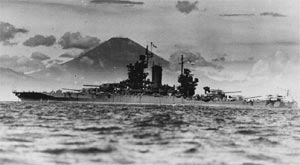New Mexico class battleship
|
|
| New Mexico class battleship | |
|---|---|

| |
| Class Overview | |
| Class Type | Battleship |
| Class Name | New Mexico |
| Preceded By | Pennsylvania-class |
| Succeded By | Tennessee-class |
| Ships of the Class: | New Mexico, Mississippi, Idaho |
The New Mexico class battleships of the United States Navy, all three of whose construction began in 1915, were improvements on the design introduced three years earlier with the Nevada class. The twelve-gun main battery of the preceding Pennsylvania class was retained, but with longer 14 in (356 mm) 50 caliber guns in improved triple turrets. Hull design was also upgraded, with a "clipper" bow for better seakeeping, and one ship was fitted with a new propulsion system, in which steam turbines turned electrical generators and the ship's propellers were driven by electric motors. Though eight secondary battery guns were located in very wet bow and stern positions and were soon removed, the rest of the ships' five inch (127 mm) guns were mounted in the superstructure, a great improvement over the earlier arrangements.
Completed during and soon after the World War I, the New Mexico class were active members of the Battle Fleet during the decades between the World Wars. All were rebuilt between 1931 and 1934, receiving entirely new superstructures, modern controls for their guns, new engines and improved protection against air and surface attack. Anti-torpedo "bulges" increased their width to 32.4 meters (106 ft 3 in) and displacement went up by a thousand tons or more.
In order to counter the German threat, these ships were transferred from the Pacific to the Atlantic in 1941, leaving the Pacific Fleet inferior in battleship strength to the Japanese Navy. Sent back to the Pacific after the Pearl Harbor Raid devastated the Pacific Fleet's battle line, they were active in the war with Japan until final victory was achieved in August 1945. Their heavy guns provided vital assistance to the many amphibious invasions that marked the Pacific conflict, and Mississippi took part in the Battle of Surigao Strait, the last time in history that battleships fought each other. New Mexico and Idaho were disposed of soon after the War ended, but Mississippi was converted to a training and weapons trials ship and served for another decade. The Navy's first generation of ship-launched guided missiles, the replacements for most of the guns that had long been the focus of her career, first went to sea aboard this old former battleship.
The New Mexico class was part of the "Standard type battleship" concept of the US Navy, a design concept which gave the US Navy a homogenous line of battle (very important, as it allowed the Navy to plan maneuvers for the whole line of battle rather than detaching "fast wing"s and "slow wing"s). The "Standard" concept included long-range gunnery, moderate speed of 21 knots (39 km/h), a tight tactical radius of 700 yards (640 m) and improved damage control. The other Standards were the Nevada, Pennsylvania, Tennessee and Colorado classes.
General characteristics
- Displacement: 32,000 tons (normal)
- Length: 190 m (624 ft)
- Beam: 29.7 m (97 ft 5 in)
- Powerplant: 27,500 horsepower (21 MW) turbines with electric drive in New Mexico, 32,000 horsepower (24 MW) geared turbines in the other two ships. All had four propellers
- Speed: 21 knots (39 km/h)
- Armament
- Main Battery: 12 x 14 in (356 mm) 50 caliber guns in four triple turrets
- Secondary Battery: 25 x 5 in (127 mm) 51 caliber guns in single casemate mountings (eleven guns on each side of the ship); soon reduced to 14 x 5 in (127 mm) 51 caliber guns. When modernized in the 1930s, two more 5 in (127 mm) 51 caliber guns were removed and 8 x 5 in (127 mm) 25 caliber anti-aircraft guns were added.
References
initially based on the public domain article published by the Department of the Navy's Naval Historical Center
| New Mexico-class battleship |
| New Mexico | Mississippi | Idaho |
| List of battleships of the United States Navy |
